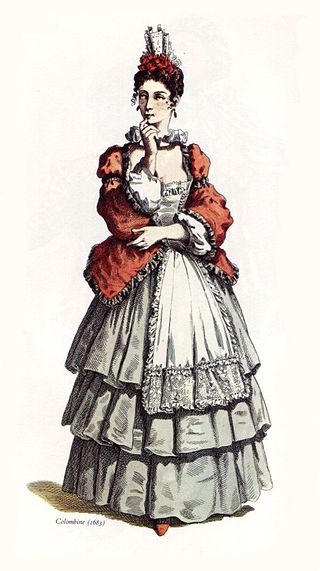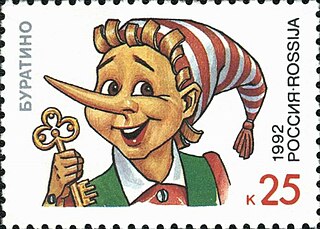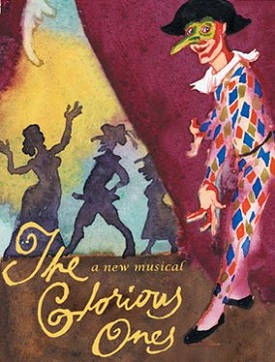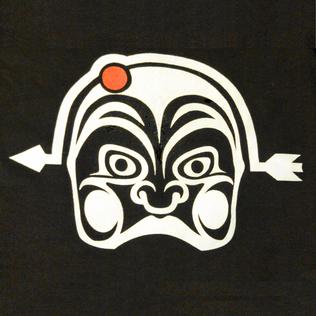

Burattino, also Burrattino or Burratino, is a minor commedia dell'arte character of the Zanni (or second Zanni) class. [1]


Burattino, also Burrattino or Burratino, is a minor commedia dell'arte character of the Zanni (or second Zanni) class. [1]
In Italian burattino means "puppet", although it is not clear whether the commedia dell'arte character was called Burattino because he moved like a puppet or puppets acquired the name because of Burattino. [2] Though only mildly popular on the stage, he found his real fame in the marionette theater. According to Pierre-Louis Duchartre, the puppet named Burattino became so popular in Italy, that "by the end of the sixteenth century, all marionettes operated by strings and a wire were called burattini, instead of bagatelli or fantoccini, as they had been known up to that time." [3] Today, the Italian word burattino can also refer to a hand puppet.
Duchartre also reproduces two illustrations from 1594 with Burattino, in which he wears a costume similar to Zani's but with a characteristic flat round hat. [4] Tommaso Garzoni (1549–1589) associates the character with a small cap called a berettino. Richard Andrews suggests the two words may be related. [5] The word berettino has also been used to refer to the ecclesiastical skullcap, more commonly known as the zucchetto.
Burattino is one of three commedia dell'arte masks mentioned by Bartolomeo Rossi in the foreword to his 1584 comic pastoral play Fiammella, as examples of low-life characters who speak the Bergamasque dialect (usually approximate), the other two being Pedrolino and Arlecchino. As a rustic dialect, it signaled the character's low social status and was used in Italian theatre into the 18th century. [6]
Burattino is in 21 of the 50 scenarios of Flaminio Scala, published in 1611. He appears as a house servant, an innkeeper, a gardener, a peasant, a beggar, and a long-lost father. [7] Like Pedrolino, Burrattino is extremely good natured. He is so trustworthy that, in the third of Scala's scenarios, "The Fortunate Isabella", the lone innamorata Isabella takes him along as her sole accompaniment on a journey across the country. [8] When he later in the play believes (mistakenly) that Isabella has been kidnapped and raped, he weeps and laments at length. [9] Buratino is the protagonist of Alexei Tolstoy's novel The Golden Key, or The Adventures of Buratino.

Harlequin is the best-known of the comic servant characters (Zanni) from the Italian commedia dell'arte, associated with the city of Bergamo. The role is traditionally believed to have been introduced by the Italian actor-manager Zan Ganassa in the late 16th century, was definitively popularized by the Italian actor Tristano Martinelli in Paris in 1584–1585, and became a stock character after Martinelli's death in 1630.

Zanni, Zani or Zane is a character type of commedia dell'arte best known as an astute servant and a trickster. The Zanni comes from the countryside and is known to be a "dispossessed immigrant worker". Through time, the Zanni grew to be a popular figure who was first seen in commedia as early as the 14th century. The English word zany derives from this character. The longer the nose on the characters mask, the more foolish the character.

Brighella is a comic, masked character from the Italian theatre style commedia dell'arte. His early costume consisted of loosely fitting, white smock and pants with green trim and was often equipped with a batocio or slapstick, or else with a wooden sword. Later, he took to wearing a sort of livery with a matching cape. He wore a greenish half-mask displaying a look of preternatural lust and greed. It is distinguished by a hook nose and thick lips, along with a thick twirled mustache to give him an offensive characteristic. He evolved out of the general Zanni, as evidenced by his costume, and came into his own around the start of the 16th century.

Columbine is a stock character in the commedia dell'arte. She is Harlequin's mistress, a comic servant playing the tricky slave type, and wife of Pierrot. Rudlin and Crick use the Italian spelling Colombina in Commedia dell'Arte: A Handbook for Troupes.
La Ruffiana is an older female character of the Commedia dell'Arte with a shady past or who used to be a prostitute. She is used most often in relationship to the vecchi of which group she is a nominal member. Ruffiana is most often romantically involved with Pantalone, though his love may easily be unrequited if it suits the plot. She is generally described as being talkative/gossipy, sneaky, and mischievous, but deep down is actually kind. She has been described as an "outsider" that always mixes things up and causes trouble for the rest of the characters. "Her quips reek of garlic"

Innamorati were stock characters within the theatre style known as commedia dell'arte, who appeared in 16th-century Italy. In the plays, everything revolved around the lovers in some regard. These dramatic and posh characters were present within commedia plays for the sole purpose of being in love with one another, and moreover, with themselves. These characters move elegantly and smoothly, and their young faces are unmasked unlike other commedia dell'arte characters. Despite facing many obstacles, the lovers were always united by the end.
Lazzi are stock comedic routines that are associated with commedia dell'arte. Performers, especially those playing the masked Arlecchino, had many examples of this in their repertoire, and would use improvisatory skills to weave them into the plot of dozens of different commedia scenarios. These largely physical sequences could be improvised or preplanned within the performance and were often used to enliven the audience when a scene was dragging, to cover a dropped line or cue, or to delight an expectant audience with the troupe's specialized lazzi.

Pantalone, spelled Pantaloon in English, is one of the most important principal characters found in commedia dell'arte. With his exceptional greed and status at the top of the social order, Pantalone is "money" in the commedia world. His full name, including family name, is Pantalon de' Bisognosi, Italian for 'Pantalone of the Needy'.

Il Capitano is one of the four stock characters of commedia dell'arte. He most probably was never a "Captain", but rather appropriated the name for himself.
Il Dottore, most commonly known in Italian as Dottor Balan or simply Balanzone, is a commedia dell'arte stock character, in one scenario being an obstacle to young lovers. Il Dottore and Pantalone are the comic foils of each other, Pantalone being the decadent wealthy merchant, and il Dottore being the decadent erudite. He has been part of the main canon of characters since the mid-16th century.

Pulcinella is a classical character that originated in commedia dell'arte of the 17th century and became a stock character in Neapolitan puppetry. Pulcinella's versatility in status and attitude has captivated audiences worldwide and kept the character popular in countless forms since his introduction to commedia dell'arte by Silvio Fiorillo in 1620.

Isabella is a stock character used in commedia dell'arte, in the class of innamorata. In the commedia dell'arte, the relationship of the innamorati, or lovers, is often threatened by the vecchi characters, but they are reunited in the end. In his 1929 book The Italian Comedy, Pierre Louis Duchartre writes that Isabella changed from being mainly tender and loving in the 16th century to a more flirtatious and strong-willed woman with a "lively, picturesque wit" by the end of the 17th century.

Buratino is the main character of Aleksey Nikolayevich Tolstoy's 1936 fairy tale The Golden Key, or the Adventures of Buratino, which is based on the 1883 Italian novel The Adventures of Pinocchio by Carlo Collodi. Buratino originated as a character in the commedia dell'arte. The name Buratino derives from the Italian burattino, which means "wooden puppet" or "doll". The book was published in 1936; the figure of Buratino quickly became hugely popular among children in the Soviet Union and remains so in Russia to this day. The story has been made into several films, including the animated 1959 film and the live-action 1975 film.

Pedrolino is a primo ('first') Zanni, or comic servant, of the commedia dell'arte; the name is a hypocorism of Pedro ('Peter'), via the suffix -lino. The character made its first appearance in the last quarter of the 16th century, apparently as the invention of the actor with whom the role was to be long identified, Giovanni Pellesini. Contemporary illustrations suggest that his white blouse and trousers constituted "a variant of the typical Zanni suit", and his Bergamasque dialect marked him as a member of the "low" rustic class. But if his costume and social station were without distinction, his dramatic role was certainly not: as a multifaceted first Zanni, his character was—and still is—rich in comic incongruities.

I Gelosi was an Italian acting troupe that performed commedia dell'arte from 1569 to 1604. Their name stems form their motto: Virtù, fama ed honor ne fèr gelosi, long thought to mean "Virtue, fame and honour made us jealous", or "We are jealous of attaining virtue, fame, and honour", signifying that such rewards could only be attained by those who sought for them jealously. Modern reevaluations have considered "zealous" as a more accurate translation over "jealous", redefining their motto to signify that, as actors, they were zealous to please.

The Glorious Ones is a musical with book and lyrics by Lynn Ahrens and music by Stephen Flaherty. Set in 17th-century Italy, it concerns a theatre group in the world of commedia dell'arte and theatre of the Italian Renaissance.

Commedia dell'arte was an early form of professional theatre, originating from Italian theatre, that was popular throughout Europe between the 16th and 18th centuries. It was formerly called Italian comedy in English and is also known as commedia alla maschera, commedia improvviso, and commedia dell'arte all'improvviso. Characterized by masked "types", commedia was responsible for the rise of actresses such as Isabella Andreini and improvised performances based on sketches or scenarios. A commedia, such as The Tooth Puller, contains both scripted and improvised portions; key plot points and characters' entrances and exits are scripted, but the actors may otherwise be expected to improvise new gags on stage. A special characteristic of commedia is the lazzo, a joke or "something foolish or witty", usually well known to the performers and to some extent a scripted routine. Another characteristic of commedia is pantomime, which is mostly used by the character Arlecchino, now better known as Harlequin.
Flaminio Scala, commonly known by his stage name Flavio, was an Italian stage actor of commedia dell'arte, scenario writer, playwright, director, producer, manager, agent, and editor. Considered one of the most important figures in Renaissance theatre, Scala is remembered today as the author of the first published collection of commedia scenarios, Il Teatro delle Favole Rappresentative, short comic plays that served as inspiration to playwrights such as Lope de Vega, William Shakespeare, Ben Jonson, and Molière.

i Sebastiani is a Commedia dell'Arte theatre troupe formed in 1990 by Jeff Hatalsky. To the present day, i Sebastiani has performed for thousands of fans across the United States and Canada. The company has travelled as far as Montreal to the north, Miami to the south, and Texas to the west, performing more than 100 different improvisational scenarios.
Diana Ponti, also known as Lavinia Ponti, was an Italian stage actress.